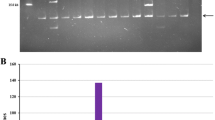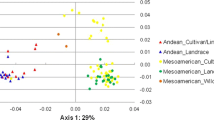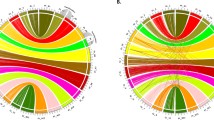Abstract
BAC-end sequences (BESs) of hybrid sugarcane cultivar R570 are presented. A total of 66,990 informative BESs were obtained from 43,874 BAC clones. Similarity search using a variety of public databases revealed that 13.5 and 42.8 % of BESs match known gene-coding and repeat regions, respectively. That 11.7 % of BESs are still unmatched to any nucleotide sequences in the current public databases despite the fact that a close relative, sorghum, is fully sequenced, indicates that there may be many sugarcane-specific or lineage-specific sequences. We found 1,742 simple sequence repeat motifs in 1,585 BESs, spanning 27,383 bp in length. As simple sequence repeat markers derived from BESs have some advantages over randomly generated markers, these may be particularly useful for comparing BAC-based physical maps with genetic maps. BES and overgo hybridization information was used for anchoring sugarcane BAC clones to the sorghum genome sequence. While sorghum and sugarcane have extensive similarity in terms of genomic structure, only 2,789 BACs (6.4 %) could be confidently anchored to the sorghum genome at the stringent threshold of having both-end information (BESs or overgos) within 300 Kb. This relatively low rate of anchoring may have been caused in part by small- or large-scale genomic rearrangements in the Saccharum genus after two rounds of whole genome duplication since its divergence from the sorghum lineage about 7.8 million years ago. Limiting consideration to only low-copy matches, 1,245 BACs were placed to 1,503 locations, covering ~198 Mb of the sorghum genome or about 78 % of the estimated 252 Mb of euchromatin. BESs and their analyses presented here may provide an early profile of the sugarcane genome as well as a basis for BAC-by-BAC sequencing of much of the basic gene set of sugarcane.




Similar content being viewed by others
References
Berding N, Roach BT (1987) Germplasm Collection, Maintenence, and Use. In: Heinz DJ (ed) Sugarcane Improvement Through Breeding. Elsevier, Amsterdam, pp 143–210
Bowers JE, Arias MA, Asher R, Avise JA, Ball RT, Brewer GA, Buss RW, Chen AH, Edwards TM, Estill JC, Exum HE, Goff VH, Herrick KL, Steele CLJ, Karunakaran S, Lafayette GK, Lemke C, Marler BS, Masters SL, McMillan JM, Nelson LK, Newsome GA, Nwakanma CC, Odeh RN, Phelps CA, Rarick EA, Rogers CJ, Ryan SP, Slaughter KA, Soderlund CA, Tang H, Wing RA, Paterson AH (2005) Comparative physical mapping links conservation of microsynteny to chromosome structure and recombination in grasses. Proc Natl Acad Sci USA 102:13206–13211
Cheung F, Town CD (2007) A BAC end view of the Musa acuminata genome. BMC Plant Biol 7:29
Conesa A, Gotz S, Garcia-Gomez JM, Terol J, Talon M, Robles M (2005) Blast2GO: a universal tool for annotation, visualization and analysis in functional genomics research. Bioinformatics 21:3674–3676
Daniels J, Roach BT (1987) Taxonomy and Evolution. In: Heinz DJ (ed) Sugarcane Improvement Through Breeding. Elsevier, Amsterdam, pp 7–84
D’Hont A, Grivet L, Feldmann P, Rao S, Berding N, Glaszmann J-C (1996) Characterization of the double genome structure of modern sugarcane cultivars (Saccharum spp.) by molecular cytogenetics. Mol Gen Genet 250:405–413
D’Hont A, Ison D, Alix K, Roux C, Glaszmann J-C (1998) Determination of basic chromosome numbers in the genus Saccharum by physical mapping of ribosomal RNA genes. Genome 41:221–225
Ewing B, Green P (1998) Base-calling of automated sequencer traces using phred. II. Error probabilities. Genome Res 8:186–194
Ewing B, Hillier L, Wendl MC, Green P (1998) Base-calling of automated sequencer traces using phred. I. Accuracy assessment. Genome Res 8:175–185
Figueira TR, Okura V, da Silva FR, da Silva MJ, Kundra D, Ammiraju JS, Talag J, Wing R, Arruda P (2012) A BAC library of the SP80-3280 sugarcane variety (Saccharum sp.) and its inferred microsynteny with the sorghum genome. BMC Res Notes 5:185
Goff SA, Ricke D, Lan T, Presting G, Wang R, Dunn M, Glazebrook J, Sessions A, Oeller P, Varma H, Hadley D, Hutchison D, Martin C, Katagiri F, Lange B, Moughamer T, Xia Y, Budworth P, Zhong J, Miguel T, Paszkowski U, Zhang S, Colbert M, Sun W, Chen L, Cooper B, Park S, Wood T, Mao L, Quail P, Wing RA, Dean R, Yu Y, Zharkikh A, Shen R, Sahasrabudhe S, Thomas A, Cannings R, Gutin A, Pruss D, Reid J, Tavtigian S, Mitchell J, Eldredge G, Scholl T, Miller R, Bhatnagar S, Adey N, Rubano T, Tusneem N, Robinson R, Feldhaus J, Macalma T, Oliphant A, Briggs S (2002) A draft sequence of the rice genome (Oryza sativa L. ssp. japonica). Science 296:92–100
Gonzalez VM, Rodfiguez-Moreno L, Centeno E, Benjak A, Garcia-Mas J, Puigdomenech P, Aranda MA (2010) Genome-wide BAC-end sequencing of Cucumis melo using two BAC libraries. BMC Genom 11:618
Grivet L, Arruda P (2002) Sugarcane genomics: depicting the complex genome of an important tropical crop. Curr Opin Plant Biol 5:122–127
Grivet L, Glaszmann J, D’Hont A (2006) Molecular evidence of sugarcane evolution and domestication. In: Motley TJ (ed) Darwin’s harvest: New approaches to the origins, evolution and conservation of crops. Columbia University Press, New York, pp 49–66
Guo Y, Saha S, Yu JZ, Jenkins JN, Kohel RJ, Scheffler BE, Stelly DM (2007) BAC-derived SSR markers chromosome locations in cotton. Euphytica 161:361–370
Ha S, Moore PH, Heinz DJ, Kato S, Ohmido N, Fukui K (1999) Quantitative chromosome map of the polyploid Saccharum spontaneum by multicolor fluorescence in situ hybridization and imaging methods. Plant Mol Biol 39:1165–1173
Han Y, Korban SS (2008) An overview of the apple genome through BAC end sequence analysis. Plant Mol Biol 67:581–588
Huo N, Lazo GR, Vogel JP, You FM, Ma Y, Hayden DM, Coleman-Derr D, Hill TA, Dvorak J, Anderson OD, Luo M-C, Gu YQ (2008) The nuclear genome of Brachypodium distachyon: analysis of BAC end sequences. Funct Integr Genom 8:135–147
Jannoo N, Grivet L, Chantret N, Garsmeur O, Glaszmann J-C, Arruda P, D’Hont A (2007) Orthologous comparison in a gene-rich region among grasses reveals stability in the sugarcane polyploid genome. Plant J 50:574–585
Jurka J, Kapitonov VV, Pavlicek A, Klonowski P, Kohany O, Walichiewicz J (2005) Repbase update, a database of eukaryotic repetitive elements. Cyto Genome Res 110:462–467
Kim C, Tang H, Paterson AH (2009) Duplication and divergence of grass genomes: integrating the Cloridoids. Trop Plant Biol 2:51–62
Kim C, Robertson JS, Paterson AH (2011) Inference of subgenomic origin of BACs in an interspecific hybrid sugarcane cultivar by overlapping oligonucleotide hybridizations. Genome 54:727–737
Lai CW, Yu Q, Hou S, Skelton RL, Jones MR, Lewis KLT, Murray J, Eustice M, Guan P, Agbayani R, Moore PH, Ming R, Presting GG (2006) Analysis of papaya BAC end sequences reveals first insights into the organization of a fruit tree genome. Mol Gen Genom 276:1–12
Le Cunff L, Garsmeur O, Raboin LM, Pauquet J, Telismart H, Selvi A, Grivet L, Philippe R, Begum D, Deu M, Costet L, Wing RA, Glaszmann JC, D’Hont A (2008) Diploid/polyploid syntenic shuttle mapping and haplotype-specific chromosome walking toward a rust resistance gene (Bru1) in highly polyploid sugarcane (2n ~ 12x ~ 115). Genetics 180:649–660
Menossi M, Silva-Filho MC, Vincentz M, Van-Sluys M-A, Souza GM (2008) Sugarcane functional genomics: gene discovery for agronomic trait development. Int J Plant Genom Article ID 458732
Ming R, Liu S-C, Lin Y-R, da Silva J, Wilson W, Braga D, van Deynze A, Wenslaff TF, Wu KK, Moore PH, Burnquist W, Sorrells ME, Irvine JE, Paterson AH (1998) Detailed alignment of Saccharum and Sorghum chromosomes: comparative organization of closely related diploid and polyploid genomes. Genetics 150:1663–1682
Ming R, Liu S-C, Moore PH, Irvine JE, Paterson AH (2001) QTL analysis in a complex autopolyploid: genetic control of sugar content in sugarcane. Genome Res 11:2075–2084
Ming R, Del Monte TA, Hernandez E, Moore PH, Irvine JE, Paterson AH (2002a) Comparative analysis of QTLs affecting plant height and flowering among closely-related diploid and polyploid genomes. Genome 45:794–803
Ming R, Wang YW, Draye X, Moore PH, Irvine JE, Paterson AH (2002b) Molecular dissection of complex traits in autopolyploids: mapping QTKs affecting sugar yield and related traits in sugarcane. Theor Appl Genet 105:332–345
Morgante M, Hanafey M, Powell W (2002) Microsatellites are preferentially associated with nonrepetitive DNA in plant genomes. Nat Genet 30:194–200
Paterson AH, Bowers JE, Chapman BA (2004) Ancient polyploidization predating divergence of the cereals, and its consequences for comparative genomics. Proc Natl Acad Sci USA 101:9903–9908
Paterson AH, Bowers JE, Bruggmann R, Dubchak I, Grimwood J, Gundlach H, Haberer G, Hellsten U, Miltros T, Poliakov A, Schmutz J, Spannagl M, Tang H, Wang X, Wicker T, Bharti AK, Chapman J, Feltus FA, Gowik U, Grigoriev IV, Lyons E, Maher CA, Martis M, Narechania A, Otillar RP, Penning BW, Salamov AA, Wang Y, Zhang L, Carpita NC, Freeling M, Gingle AR, Hash CT, Keller B, Klein P, Kresovich S, McCann MC, Ming R, Peterson DG, Rahman M, Ware D, Westhoff P, Mayer KF, Messing J, Rokhsar DS (2009) The Sorghum bicolor genome and the diversification of grasses. Nature 457:551–556
Piperidis G, Piperidis N, D’Hont A (2010) Molecular cytogenetic investigation of chromosome composition and transmission in sugarcane. Mol Genet Genom 284:65–73
Rampant PF, Lesur I, Boussardon C, Bitton F, Martin-Magniette M-L, Bodenes C, Le Provost G, Berges H, Fluch S, Kremer A, Plomion C (2011) Analysis of BAC end sequences in oak, a keystone forest tree species, providing insight into the composition of its genome. BMC Genom 12:292
Schlueter JA, Goicoechea JL, Collura K, Gill N, Lin J-Y, Yu Y, Kudrna D, Zuccolo A, Vallejos CE, Munoz-Torres M, Blair MW, Tohme J, Tomkins J, McClean P, Wing RA, Jackson SA (2008) BAC-end sequence analysis and a draft physical map of the common bean (Phaseolus vulgaris L.) genome. Trop Plant Biol 1:40–48
Sharma MK, Sharma R, Cao P, Jenkins J, Bartley LE, Qualls M, Grimwood J, Schmutz J, Rokhsar D, Ronald PC (2012) A genome-wide survey of switchgrass genome structure and organization. PLoS ONE 7:e33892
Shultz JL, Kazi S, Bashir R, Afzal JA, Lightfoot DA (2007) The development of BAC-end sequence-based microsatellite markers and placement in the physical and genetic maps of soybean. Theor Appl Genet 114:1081–1090
Souza GM, Berges H, Bocs S, Casu R, D’Hont A, Ferreira JE, Henry R, Ming R, Potier B, Van Sluys MA, Vincentz M, Paterson AH (2011) The sugarcane genome challenge: strategies for sequencing a highly complex genome tropical. Plant Biol 4:145–156
Sreenivasan TV, Ahloowalia BS, Heinz DJ (1987) Cytogenetics. In: Heinz DJ (ed) Sugarcane Improvement Through Breeding. Elsevier Press, Amsterdam, pp 211–253
Tomkins JP, Yu Y, Miller-Smith H, Frisch DA, Woo SS, Wing RA (1999) A bacterial artificial chromosome library for sugarcane. Theor Appl Genet 99:419–424
Tomkins J, Fregene M, Main D, Kim H, Wing RA, Tohme J (2004) Bacterial artificial chromosome (BAC) library resource for positional cloning of pest and disease resistance genes in cassava (Manihot esculenta Crantz). Plant Mol Biol 56:555–561
Acknowledgments
This study was supported by grants from the International Consortium for Sugarcane Biotechnology (#24), Consortium for Plant Biotechnology Research (DE-FG36-02GO12026), and the Univ. Georgia Office of the Vice President for Research, to AHP.
Author information
Authors and Affiliations
Corresponding author
Electronic supplementary material
Below is the link to the electronic supplementary material.
Rights and permissions
About this article
Cite this article
Kim, C., Lee, TH., Compton, R.O. et al. A genome-wide BAC end-sequence survey of sugarcane elucidates genome composition, and identifies BACs covering much of the euchromatin. Plant Mol Biol 81, 139–147 (2013). https://doi.org/10.1007/s11103-012-9987-x
Received:
Accepted:
Published:
Issue Date:
DOI: https://doi.org/10.1007/s11103-012-9987-x




